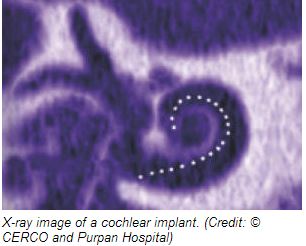Hearing Through Sight: Brain Plasticity and Why Cochlear Implants Work Better for Some People Than Others
[Source: Science Daily]

Cochlear implants allow adults who have become profoundly deaf to recover the ability to understand speech. However, recovery differs between individuals. Activating the visual regions of the brain has proved essential to the satisfactory recovery of hearing, according to a new study by the Centre de Recherche Cerveau et Cognition (CERCO, CNRS/Université Toulouse III — Paul Sabatier), carried out in close collaboration with the ENT department at Hôpital Purpan in Toulouse. The more the area of the brain responsible for vision is activated immediately after implantation, the better the individual’s speech understanding performance six months later. There is therefore a synergy between sight and hearing, resulting in a gradual improvement in the decoding of speech. These findings, which have just been published in Brain, illustrate the crucial role of brain plasticity. And they may make it possible to develop diagnostic tools for specific rehabilitation.
Cochlear implants are an effective alternative for people suffering from profound deafness (with a hearing threshold greater than 90 decibels)* to emerge from a silent world. Implanted in the inner ear during a surgical procedure, these auditory neural prostheses transform external sounds into electrical impulses that directly stimulate the auditory nerve, leading to a marked recovery of hearing capacity. On average, people who, after becoming deaf, could only recognize one in five words before implantation are able to distinguish more than 80% of words afterwards. However, the degree of recovery may vary on an individual basis.
Read the Rest of this Article on Science Daily
PediaStaff is Hiring!
All JobsPediaStaff hires pediatric and school-based professionals nationwide for contract assignments of 2 to 12 months. We also help clinics, hospitals, schools, and home health agencies to find and hire these professionals directly. We work with Speech-Language Pathologists, Occupational and Physical Therapists, School Psychologists, and others in pediatric therapy and education.
